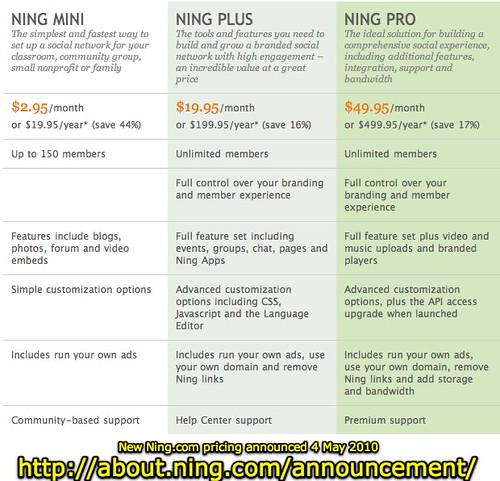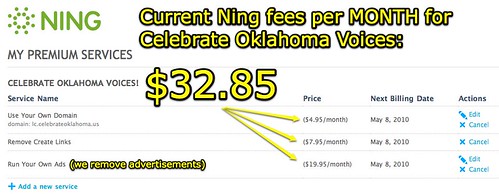Today as anticipated, Ning announced a new pricing structure for its websites which will be implemented in July 2010. Free sites will be phased out, and options will be provided for current site owners (who do not want to start paying) to export their content for re-use elsewhere.
The Ning Announcement page includes the following tantalizing statement for educators:
A major educational company has offered to sponsor Ning Mini Networks for educators globally in primary and secondary education. More details to come soon!
I wonder who that “major educational company” is? We’ll find out soon, I’m sure.
Personally, I think the proposed price structure is VERY reasonable. A detailed breakdown of the three tiers is available from Ning. Paying $20 US a year for the functionality of Ning is very doable for most U.S. teachers. Would it be better to have a FREE Ning website with advertising? Perhaps for some, but I’m not so sure. Paying $20 a year to have ALL ads removed from your classroom Ning sounds great to me. I’m really averse to advertising, especially for students on sites they are REQUIRED to use for class assignments. Previously Ning would remove ads for educational sites, but I know many educators didn’t realize this and ran their Ning sites with ads. $20 to keep a classroom Ning site and remove ads seems very palatable to me.
Currently our Storychasers nonprofit is paying $32.85 PER MONTH for our Celebrate Oklahoma Voices learning community / Ning, to use a custom domain, remove Ning network “create links” and remove advertisements.
That is $394.20 per year. Under this new pricing structure, it looks like could opt for the PRO level and pay a little over $100 MORE per year to Ning, and get some additional features we do not have today including (eventual) API access. Alternatively we could pay LESS ($20 per month or $200 per year) and maintain our existing videos on the site, but not have some advanced features like API access.
This summer Storychasers is launching a pilot for “Celebrate Kansas Voices.” These changes in pricing for Ning will certainly affect how we extend our project to other states. It does provide additional incentives to move forward with a RFP for a video encoding website solution that we’ve discussed for several months. This would be a site to which our members upload videos for transcoding, and then copy embed code which is used within the Ning. If we transition to that process for sharing videos, we should be able to use “Ning Plus” accounts for state learning community websites. I’m sure we’ll discuss these issues in greater depth at our upcoming COV facilitator retreat this Saturday.
I’m interested to learn more details about the educator site sponsorships which will be available. Steve Hargadon wrote a thorough post breaking down the pros and cons of today’s announcement, and included the following tidbit NOT included in the official Ning annoucements about what will constitute an “educational” site:
This is official, straight from John McDonald. The sponsored Mini networks can be used for professional development networks for primary and secondary educators, and can be used for teacher-led student/classroom networks for students 13+ in secondary (high school) institutions. Ning’s terms of service will continue to require that anyone signing up for a Ning network be 13 years of age or older.
No mention of university pre-service teacher networks. Perhaps those will be considered PD sites for primary/secondary teachers?
A big implication of these Ning pricing changes, as I noted on April 16th, is going to be much more exploration of alternative educational networking / social networking platforms on the part of educators. This is a good thing. I was very interested learn from Levi Patrick today that the K20 Alt program and community at the University of Oklahoma is going to be moving toward the use of Buddypress (on the WordPress platform) in the coming months. As a major WordPress fan, I’m eager to learn more about the features and extensibility of Buddypress, so it will be great to have a local group to learn with/from on that front.
I’ve created seven different Ning networks in the past, and I suspect the Celebrate Oklahoma Voices and Celebrate Kansas Voices networks will be the only ones I’ll plan to continue for sure. I’ve dabbled a bit with my “Digital Dialog” Ning, but it’s not something I’m likely to continue if I have to pay for it. Our K-12 Online Conference organizer team will have to discuss the fate of our K12Online Ning. I’m not entirely convinced our use of the Ning last year was good thing, it was confusing to have content and conversations over on the blog AND on the Ning. Perhaps utilizing Buddypress would be a solution for K12Online? It’s possible Celebrate Kansas Voices could eventually utilize a Buddypress installation on a subdomain of our storychasers.org or storychasers.tv domain too. Lots of possibilities to discuss. A free import plugin is available for folks migrating from Ning to BuddyPress.
What are your initial reactions to Ning’s pricing announcement today?
Technorati Tags:
change, ckv, collaborate, community, cov, edtech, education, learning, ning, storychasers, video, pricing
If you enjoyed this post and found it useful, subscribe to Wes’ free newsletter. Check out Wes’ video tutorial library, “Playing with Media.” Information about more ways to learn with Dr. Wesley Fryer are available on wesfryer.com/after.
On this day..
- QR Codes on Conference Bookmark Handout – 2012
- Thank You Teachers (Teacher Appreciation Week Message) – 2011
- Visually Capturing Stress in the White House During SEAL Operations Against Bin Laden – 2011
- Quickly publish student writing with WordPress and iPadio (no-edit podcasts) – 2010
- Celebration of Collaboration – 2007
- Online science activities – 2006
- Just say no to fear – 2006



Comments
2 responses to “Ning announces new pricing structure – Implications for Storychasers”
The price structure is reasonable, but the limit of 150 members in the Ning Mini option is a bummer in many situations. It’s fairly easy tosurpass those numbers when you’re working with a school community, even if it’s not an institutional project but one led by a teacher or a small group of teachers without any funding.
Another thing to keep in mind is that the huge differences in income around the world make this “very reasonable” highly questionable in many circumstances.
Initial reaction? K-12 education has been thrown a bone to quiet us down while Ning shifts to a “pay for play” format.
What is offered to middle and high school teachers is Ning “Mini”: a cap of 150 members (most middle and high school teachers have larger student loads) with no access to most of the features used by teachers and their students (Groups, Events, Chat, Notes, and Ning Apps such as Huddle Workspaces and Quiz). Quite frankly, my students and I have the same level of access and collaboration through LiveJournal, WordPress, Blogger, DreamWidth, or even FaceBook.
The executives overseeing this change to Ning should take a look at how teachers use Ning in and out of their classrooms, and make their decisions based on the data, rather than simply offering the minimum and expecting teachers to be satisfied with just crumbs. After all, teachers are training Ning’s future customer base.